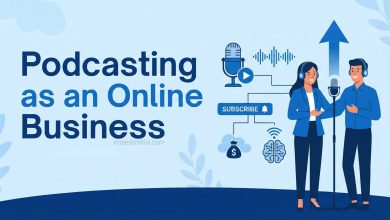How to Start a Blog or a Newsletter: Make Money Online – A Comprehensive Guide – 2025
How To Start a blog or a newsletter : Starting a blog or a newsletter is a powerful way to share your thoughts, ideas, and expertise with a global audience. Whether you want to build a personal brand, promote a business, or simply connect with like-minded individuals, blogs and newsletters can serve as versatile platforms. But how do you go about starting one?
Table of Contents
This guide will walk you through the steps involved in launching a blog or a newsletter, covering everything from the initial concept to growth strategies.
1. Decide on the Purpose and Audience
Before you start a blog or a newsletter, it’s essential to clarify your purpose and target audience. Knowing why you’re starting and who you’re trying to reach will guide many of your decisions moving forward.
- Blog Purpose: Is it to share personal experiences, build authority in a niche, or promote products and services? For example, a food blog may focus on sharing recipes, restaurant reviews, or cooking tips.
- Newsletter Purpose: Newsletters often serve a more targeted function, such as delivering regular updates, exclusive content, or personalized insights directly to your subscribers’ inboxes. Decide if your newsletter will be informative, promotional, or community-building.
- Identify Your Target Audience: Understanding your audience is key. Are you speaking to beginners in your niche or more advanced readers? This will influence your writing tone, the depth of your content, and how you market your blog or newsletter.
2. Choose Your Platform
Your next step is to decide where to host your blog or newsletter. Each platform offers different features, ease of use, and customization options.
For Blogs:
- WordPress.org: The most popular platform, WordPress.org offers complete control over your blog with customizable themes, plugins, and SEO tools. However, it requires hosting and some technical knowledge.
- Blogger: A simpler, free platform owned by Google. It’s great for beginners but lacks the flexibility and customization options of WordPress.
- Wix/Squarespace: Drag-and-drop website builders with built-in blogging capabilities. These are user-friendly and come with beautiful design templates, but they can be limited in terms of advanced features.
- Medium: If you don’t want to worry about web hosting or design, Medium is a no-frills platform that focuses entirely on content. However, it doesn’t allow for much customization or control over monetization.
Also Read ::: How To Become an Online Fitness Trainer : Make Money Online
For Newsletters:
- Substack: A popular choice for writers and journalists. Substack allows you to send emails to your subscribers and also publish your content online. It’s free to start but takes a percentage of your paid subscriptions.
- Mailchimp: A more traditional email marketing platform that allows you to send newsletters, segment your audience, and track analytics. It’s great for businesses looking to build an email list.
- ConvertKit: Designed with creators in mind, ConvertKit offers excellent features for segmentation, automation, and creating paid newsletters. It’s ideal if you’re looking to scale your audience over time.
3. Select a Niche or Topic

The success of your blog or newsletter often hinges on your ability to carve out a niche. A focused topic helps you attract a dedicated audience and position yourself as an expert in that space.
- Niche Examples for Blogs: Travel, personal finance, wellness, technology reviews, fashion, or DIY crafts.
- Newsletter Niche Examples: Industry news, startup growth tips, curated content, book summaries, or sustainability updates.
When selecting a niche, consider what you are passionate about and where you can offer value. If you’re unsure about your niche, start broad, then refine your focus as you gather insights about what resonates most with your audience.
4. Secure a Domain and Hosting (For Blogs)
If you’re serious about your blog and want to grow it professionally, you’ll need a custom domain (yourblogname.com) and web hosting.
- Domain Name: Choose a memorable, easy-to-spell domain name that reflects your niche or personal brand. Many hosting services offer free domain registration when you sign up for a hosting plan.
- Web Hosting: Hosting is where your blog’s content will be stored and accessed online. Reliable web hosting ensures your site runs smoothly and loads quickly. Popular options include:
- Bluehost: Affordable, beginner-friendly, and integrates easily with WordPress.
- SiteGround: Known for speed and excellent customer support.
- HostGator: Offers budget-friendly plans with solid uptime.
If you’re starting with a newsletter, you can bypass this step, as platforms like Substack, ConvertKit, and Mailchimp handle all the hosting for you.
5. Design Your Blog or Newsletter Layout
The design of your blog or newsletter plays a crucial role in attracting and retaining readers. It needs to be visually appealing, easy to navigate, and reflective of your brand.
For Blogs:
- Choose a Theme: Most platforms offer free and paid themes. A good theme should be clean, responsive (mobile-friendly), and customizable. WordPress has thousands of themes, while platforms like Squarespace come with built-in design templates.
- User Experience (UX): Ensure that your blog is easy to navigate. Use categories and tags to organize posts and make it easy for readers to find what they’re looking for.
- Logo and Branding: Create a logo or choose a font and color scheme that aligns with your personal brand or blog’s purpose.
For Newsletters:
- Format and Layout: Keep the design simple. Focus on clear headlines, concise sections, and well-organized content. Many platforms offer pre-built templates to make your newsletter look professional.
- Personalization: Make your emails feel personal by including the subscriber’s name and using a conversational tone. This can boost engagement and build stronger relationships with your readers.
6. Start Creating Content
Now that the foundation is set, it’s time to focus on the most critical part: the content. Whether it’s a blog post or a newsletter issue, your content needs to provide value to your audience.
Content Creation for Blogs:
- Research Your Topics: Use tools like Google Trends, Ubersuggest, and AnswerThePublic to see what topics people are searching for in your niche.
- Write Consistently: Set a content calendar to stay consistent. This not only helps you stay organized but also keeps readers engaged.
- SEO (Search Engine Optimization): Learn the basics of SEO to ensure your blog posts rank on search engines. Focus on keyword research, meta descriptions, title tags, and building backlinks to grow your organic traffic.
Content Creation for Newsletters:
- Frequency: Decide on how often you’ll send out newsletters (weekly, bi-weekly, monthly). Consistency is key, so choose a schedule you can stick to.
- Curated vs. Original Content: Newsletters can be a mix of original content (articles, tips, stories) and curated content (links to other useful articles or resources).
- Engagement: Include calls-to-action (CTAs) to encourage your readers to reply, take a survey, or share your newsletter with others. Engagement helps build a community around your content.
7. Build and Grow Your Audience

Once your blog or newsletter is up and running, it’s time to attract readers and subscribers. Audience growth is crucial for sustaining and scaling your content.
For Blogs:
- Promote on Social Media: Share your blog posts on platforms like Twitter, Facebook, Instagram, or LinkedIn to reach a wider audience.
- Collaborate with Other Bloggers: Guest posting on other blogs or collaborating on content can introduce your blog to a new audience.
- Email Marketing: Start an email list to notify your readers whenever you publish new posts. Offer incentives, like a free guide or e-book, to encourage them to subscribe.
For Newsletters:
- Leverage Social Proof: If people are enjoying your newsletter, ask them to share it with their friends or colleagues. Word-of-mouth can be a powerful tool in growing your subscriber base.
- Lead Magnets: Offer a free resource or exclusive content in exchange for email sign-ups. This encourages people to subscribe to your newsletter.
- Cross-Promote: Partner with other newsletter creators for cross-promotions or shout-outs to tap into their subscriber base.
8. Monetization Strategies
Once your blog or newsletter has a solid audience, you may want to consider monetization.
For Blogs:
- Advertising: Sign up for ad networks like Google AdSense to display ads on your blog and earn revenue based on views and clicks.
- Affiliate Marketing: Recommend products or services relevant to your audience and earn a commission on any sales made through your referral links.
- Sponsored Posts: As your blog grows, companies may approach you for sponsored posts, where you review or promote their products for a fee.
For Newsletters:
- Paid Subscriptions: Platforms like Substack or ConvertKit allow you to offer a paid tier for subscribers who want access to premium content.
- Affiliate Marketing in Emails: Just like with blogs, you can include affiliate links in your newsletters to generate income from product recommendations.
- Sponsorships: Once you have a sizable subscriber base, brands may be willing to sponsor your newsletter for exposure to your audience.
9. Analyze and Improve
Finally, continually monitor your blog or newsletter’s performance to understand what’s working and where improvements are needed.
- Google Analytics (For Blogs): Track how many visitors your blog receives, where they’re coming from, and which posts are performing best. Use these insights to refine your content strategy.
- Newsletter Analytics: Most platforms like Substack and Mailchimp offer analytics that show open rates, click-through rates, and subscriber growth. Use this data to experiment with subject lines, email frequency, and content types.
How To Start a blog or a newsletter – Conclusion

Starting a blog or newsletter requires time, effort, and planning, but the rewards are significant. Whether you’re looking to share your passions, grow a community, or build a business, blogs and newsletters offer endless opportunities for connection and creativity.
Buy Now : Blog Or News & Magazine Website AI Automated
By following the steps outlined in this guide—from choosing a platform to creating content and growing your audience—you can set yourself up for success in the world of online content creation.
Keywords : How To Start a blog or a newsletter – How To Start a blog or a newsletter 2024 – How To Start a blog or a newsletter 2025 , How To Start a blog or a newsletter In India , How To Start a blog or a newsletter Now , How To Start a blog or a newsletter Today , How To Start a blog or a newsletter free



